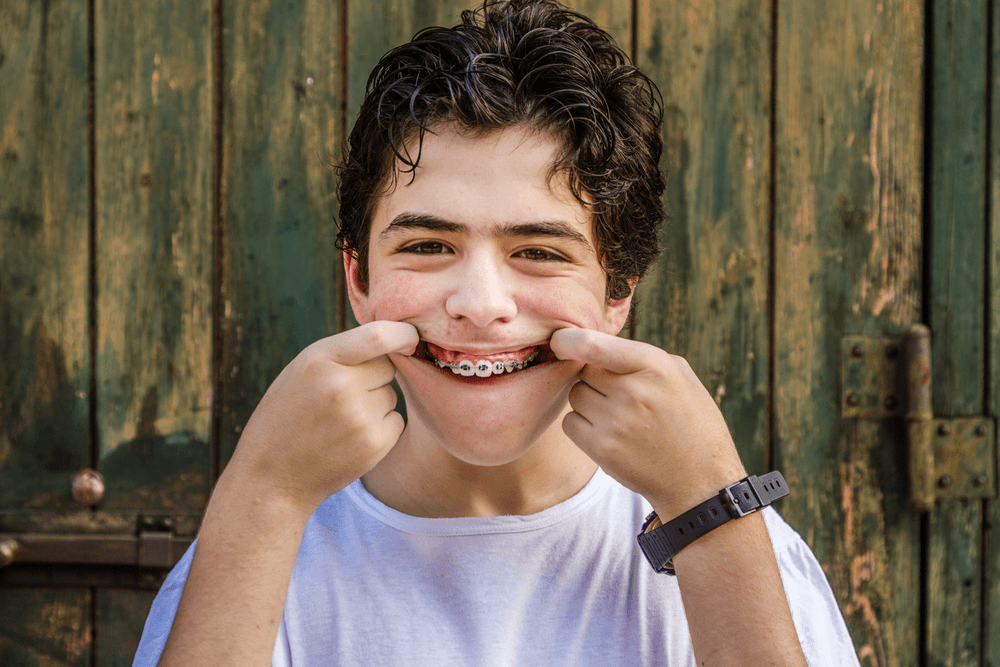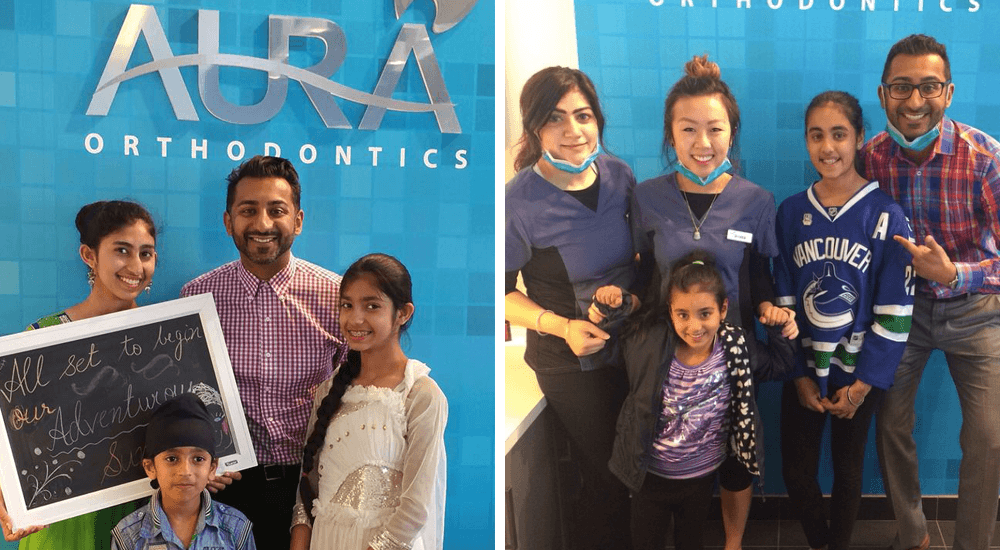
The thought of getting braces on to achieve your dream smile is exciting but it can also be overwhelming when you’re not sure of what to expect. First, let us reassure you that orthodontic treatment won’t drastically change your lifestyle, aside from the fact that when you’re finished, you’ll get a huge boost in confidence and oral health.
In fact, the majority of our Abbotsford and Surrey braces patients are pleasantly surprised with how easy the process is and with the Aura Orthodontics team in your corner, you’ll have some fun while your new smile takes shape. Yet, we know you probably have a few questions like can you chew gum with braces? Or, how much do braces cost? We’ve got it covered with our guide to everything you need to know about getting braces on and breezing through treatment.
How do Braces Work and What are the Different Types of Braces?
First things first, what are braces and how do braces work? Well, dental braces are fixed orthodontic appliances, which means, unlike a removable treatment such as Invisalign (another amazing option), braces stay in place until we’re ready to take them off. With braces, we bond brackets to your teeth and then run archwires – one on the top and one on the bottom – through them and secure everything in place with tiny elastics or metal ties.
This system of brackets and wires exerts gentle, steady pressure to move the teeth into their new positions. We sometimes use additional appliances or components like bands or a power chain to provide the necessary connective forces to improve the relationship between the upper and lower jaw.
Dental braces are designed to correct malocclusion, which is when the top and bottom teeth don’t come together correctly when you bite down. Types of malocclusion include crowding, an underbite, a crossbite, spacing or an overbite (overjet). The underlying cause of malocclusion can be skeletal or dental and only a certified specialist in orthodontics like Dr. Sharma or Dr. Lin can develop an accurate diagnosis and determine if getting braces on is the way to go for your smile. In the meantime, take our “Do I Need Braces?” quiz to get a good idea if they could be a possibility.
As far as the types of braces, there’s something to suit everyone. Traditional metal braces are what most people think of. They’re made of stainless steel and have the usual brackets and archwires. They work really well for patients of all ages and can be effective in treating more complex cases.

While they used to be a little unwieldy, thanks to innovations in orthodontic engineering, they’re smaller and comfier than ever before, meaning no more stereotypical metal mouth look. Kids tend to like them because they have the option of using colorful elastics with their metal braces.
We also offer clear braces in Surrey and Abbotsford at our offices. They’re crafted from pure grown sapphire that’s heat polished, making them strong, smooth and, best of all, clear. They’re a lot less noticeable than metal braces, which is why they’re awesome for teens and adults who want the straightening power of braces in a more esthetic form.
While you can get conventional metal and clear braces, there are also self-ligating braces. This type relies on brackets and wires but doesn’t require ligatures (elastics or metal ties). Instead, little doors hold the wires in place and the wires move along with your teeth.
How Much do Braces Cost?
The cost of braces is one of the first things most people want to know. Unfortunately, there isn’t a hard and fast rule since the price tag is influenced by a variety of factors like the type of treatment you choose, how complex your case is, how well you follow your orthodontist’s instructions and even where you live.
At Aura Orthodontics, we don’t want the cost of braces to dissuade anyone from getting a smile they love. Therefore, we offer flexible financing including interest-free monthly payment plans. We also accept assignment/insurance if your plan offers coverage. We’ll work with you to make orthodontic treatment fit your budget. Contact us today, to learn more.
A Word On DIY Braces
Before we get into the braces procedure, we have to address the alarming DIY braces trend. People of all ages (it’s not just young kids) have been attempting to save time and money by straightening their teeth on their own with things like rubber bands, hair ties and dental floss and there are video tutorials abound online.
Not only is it ineffective, it’s also extremely dangerous. Orthodontists are specialists in using orthodontic appliances to straighten the teeth and shift the jaw and we have an in-depth knowledge of the mechanics of the bite and the biological mechanisms involved in moving the teeth. Orthodontics can cause permanent changes to your facial structure, so leaving it in the hands of a professional is definitely advisable.
Using objects to move your teeth on your own can result in damage to your gum tissue and periodontal ligaments, tooth loss and long-term issues with oral health. In the end, fixing the damage will cost way more than it would have to straighten your teeth under an orthodontist’s care. With that out of the way, on to the good stuff.
Interested in braces? Give us a call today
Your Treatment: Getting Braces Put On, Adjustments and the Big Reveal
We know, we know. There are wires, brackets, bands and tools galore at our offices and that isn’t exactly the most reassuring assortment of items but we promise, getting braces put on doesn’t hurt at all and there are no shots involved. After you’ve had your consultation and Dr. Sharma or Dr. Lin has developed a customized diagnosis and treatment plan for you, you’ll hop up in our chair and one of the Aura team members will polish your pearly whites.
We’ll apply a special solution that lightly roughens the surface of your teeth so that the glue can penetrate and your braces will stay on. Once it does its job, we wash it off, dry the teeth and apply a conditioner. Next, we place the brackets, which already have the adhesive on them, one by one, removing excess glue as we go and hardening them with a light. When the brackets are where we want them, we run the wire through them, secure the wire with elastics and let you admire your new tooth accessories.
We’ll give you all of the information you need to take care of your braces and we’ll probably call you later to make sure everything’s going okay. That’s it. Getting braces on doesn’t actually feel like much of anything, though your teeth might be sensitive for a few days after. If you want to be extra prepared and find out exactly what you’re getting into, you can even watch a video of Dr. Sharma putting braces on a real patient.

Throughout your treatment, you’ll come in for regular adjustments. Appointments are typically spaced about four to six weeks apart but they can be more or less frequent depending on your needs. At your visits, we’ll make the necessary tweaks and keep an eye on your progress. If you have questions, it’s the perfect time to ask us.
So, how long do braces stay on? It depends on a variety of things like the severity of your case and how well you care for your braces. Some patients wear braces for as little as six months while for others, it can be several years. However, most people are finished treatment in 12 to 24 months. Getting your braces taken off is just as painless as getting braces on.
After we congratulate you, we’ll slide your wires out and use special instruments to remove the brackets. Then, we’ll get rid of the adhesive and polish and clean your teeth. You can take all the time you want to check out your stunning smile in the mirror. If you’re up for it, we’ll snap some photos to add you to the super prestigious Aura Orthodontics’ Wall of Fame.
When your braces treatment is complete, we’ll fit you for a retainer. Wearing a retainer is the only way to hold your teeth in their new places and maintain your results for life. Usually, patients use a retainer full-time at first and then transition to using it only at night. When you see how awesome your outcome from braces is, a retainer won’t seem like a big deal.
What to Eat With Braces
Getting braces on doesn’t mean you’ll have to give up all of your favorite foods. You can still eat the majority of them with a few exceptions. However, you’ll want to watch your chewing and biting technique so you don’t damage your brackets or wires. Never bite into food with your front teeth. Instead, break or cut up food into bite-sized pieces and chew with your back teeth. Making things as easy to eat as possible will keep your braces in top-notch shape.
Can you chew gum with braces? Unfortunately, no. Gum will get stuck in your braces and it can also cause breakage. In addition to gum, stay away from other really sticky foods like taffy, Starburst and caramel, hard stuff like ice (chewing on it), bagels, whole raw apples or carrots and pizza crust and things that are very chewy.
Popcorn and small nuts are also best to save until after treatment because they can get lodged in your braces and cause inflammation or infection. Eat sugary and starchy foods in moderation because they’re cavity culprits (we’re looking at you, cookies and white bread). You’ll also want to limit your intake of soda, sports drinks and other sugar-packed beverages since they too can lead to tooth decay. Other than that, everything else is pretty much fair game.

If you’re wondering what to eat with braces, here are some of our favorite braces-friendly foods:
- Yogurt
- Soft and thinly-sliced cheeses (brie, thin slices of cheddar, cottage cheese)
- Pudding
- Milk
- Tofu
- Soft-cooked meat
- Chicken, tuna and egg salad
- Meatloaf and meatballs
- Thinly-sliced lunch meats
- Soft, seedless bread (take off the crust if needed)
- Muffins with no chunks or nuts
- Avocados (gauc!)
- Beans
- Tortillas (heat them to make them softer)
- Grains
- Rice
- Noodles
- Pasta
- Pancakes
- Fish sticks cut into bite-sized pieces
- Crab cakes
- Soft-cooked fish
- Steamed vegetables
- Soups
- Mashed potatoes
- Hummus
- Bananas
- Applesauce
- Baked fruits or other soft, ripe fruits
- Milkshakes
- Smoothies
- Ice cream without nuts, chocolate chips or chunks
- Gelato, frozen yogurt, granita
- Cold drinks
- Ice water
- Cheesecake
- Jell-O
- Protein shakes
- Steamed leafy greens
- Soft cakes and cookies
How to Brush and Floss With Braces
Having brackets and wires in your mouth does make keeping your teeth clean a little more challenging and since food gets caught in the hardware, you’ll have to be diligent about brushing and flossing to maintain healthy teeth and gums. When wearing braces, brush your teeth in the morning, after every meal and snack and before bed. Bringing a travel toothbrush and some toothpaste with you when you’re at school or work is a smart thing to do. If you forget your supplies, at the very least, rinse your mouth really well with water after eating.
As for how to brush teeth with braces, use non-whitening, fluoride toothpaste (since parts of your teeth will be covered, you don’t want to just whiten the exposed areas). Start by brushing the biting surfaces of your teeth. Then, brush the inside surfaces of the teeth. Brush in an up and down motion on the inside of the front teeth. When brushing the outside surfaces of the teeth, begin on the bottom half.
Angle the toothbrush upwards and gently work your bristles under the wire and in between any two brackets. Wiggle the brush back and forth until the area is clean and move on to the next spot. Finish up by lightly brushing along the gum line. Do this for two minutes each time you brush and treat yourself to a new toothbrush every three months. Interproximal brushes can be a good way to supplement your standard brushing and get into hard-to-reach areas.
Floss your teeth once a day, preferably at night. People are usually a little perplexed about how to floss with braces but once you get the hang of it, you’ll be a pro. You can purchase special floss for braces or just use regular dental floss with a floss threader. When you have the floss under the wire and in between two teeth, slide it up and down against the side of one tooth and then do it again against the side of the other tooth and repeat until you’ve flossed your whole mouth. If you’re having trouble with it, ask us and we’ll give you a demonstration.
Troubleshooting Braces
It’s very rare that a real emergency with braces happens but, occasionally, there can be a minor mishap. The good news is most braces problems can be handled at home. After you’ve taken care of the immediate nuisance, contact us and we’ll let you know if you need to come in to have your braces fixed. If it’s after hours, still give us a ring and listen to the instructions on our voicemail.
 Here are the most common braces issues and how to deal with them:
Here are the most common braces issues and how to deal with them:
- Sore Teeth – Getting braces on doesn’t hurt but afterwards, your teeth can be a little sensitive and the same goes for following adjustments. Stick to soft foods and drinks for a few days and try sipping on cold beverages. If you’re teeth and jaws are still sore, you can take an over-the-counter pain reliever like Tylenol. Discomfort is really mild and you should never have braces pain. If something hurts a lot, call us right away.
- Irritation – It takes a week or two to get used to wearing braces and eventually your mouth toughens up. During the acclimation period, the brackets and wires can irritate your cheeks and gums. Make a saltwater rinse (1/2 teaspoon of salt dissolved in a glass of warm water) and swish it around in your mouth as often as needed. You can also roll a tiny piece of orthodontic wax between your fingers and stick it on the bracket or wire that’s bothering you.
- Poking Wires and Broken Brackets – For a poking wire, you can carefully use the eraser end of a pencil or cotton swab and push the wire out of the way. If it continues to jab you, dry the wire off and then cover it with a piece of dental wax that you’ve warmed up by rolling between your fingers. If the piece of wire is really long, which can happen if a bracket in the back of your mouth breaks, you can sterilize nail clippers and use them to extremely gently snip the extra wire. For a broken bracket, slide it into place and cover it with your wax. If it’s in the back of the mouth, you might be able to carefully pull it off the wire but make sure you don’t damage any other brackets in the process. For either situation, call our office and we’ll schedule you for a repair appointment.
Now that you know you know the ins and outs of getting braces on, we hope you feel confident about the teeth-straightening process. Your fantastic new smile starts with a consultation and if you’re in the market for Surrey or Abbotsford braces treatment, contact Aura Orthodontics to schedule your free exam. We’ll partner with you to make the experience positive and enjoyable while helping you achieve exceptional results.





